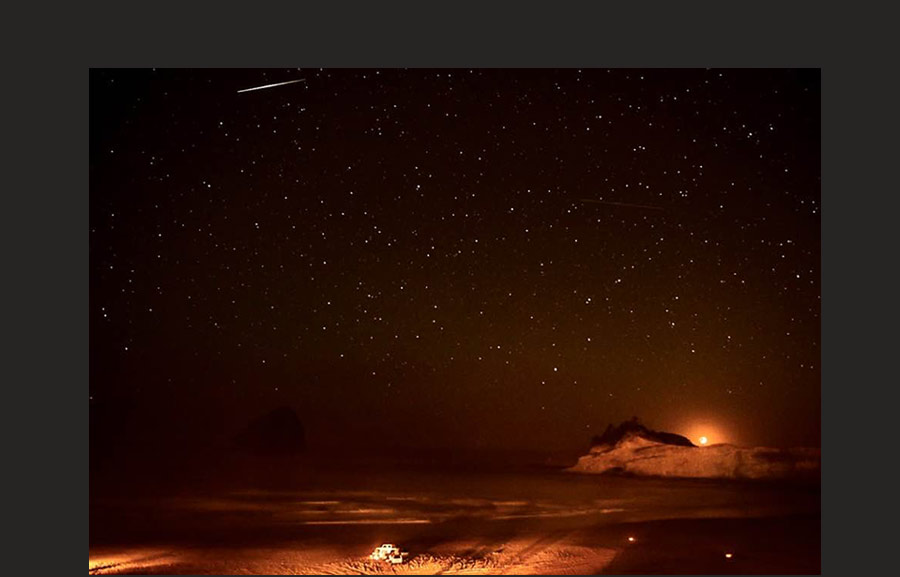Published 11/22/23 a 6:35 p.m.
By Oregon Coast Beach Connection staff

(Pacific City, Oregon) – So many of us keep hoping for the ultimate proof of what’s out there. There’s just gotta be other life in the universe, right? (Photo courtesy Pilar French)
Sometimes, however, there’s simply proof we’ve got to continue looking up. That can come in the form of a random visitor photograph from the beach: one that’s definite reason to utilize this aspect of the Washington coast and Oregon coast that’s rather neglected. Make sure you check out those night skies when you’re on the beach.
Case in point: Pilar French caught this rather esoteric moment above Cape Kiwanda. It wasn’t recent: the photo is 2019. A satellite stretches its streak across a dense layer of stars just above the famed attraction (which is now falling apart at an increasing rate, by the way). It’s not a pro shot using a tripod. In fact, it’s definitely shaky and oddly-tinted with the yellow cast of city streetlights. [See Cape Kiwanda Complete Guide]
Yet it’s a random, glorious moment. French told Oregon Coast Beach Connection she thinks it was about a ten-second exposure on her cellphone. In fact, she doesn’t recall actually even seeing the satellite. She just knows it was there after she took this random night shot.
It’s certainly true satellites don’t always show up to the naked eye.
Indeed, this one looks more like an iridium flare – a sight that is almost completely gone now. This is the glint of a satellite’s reflective surface as it catches sunlight on its way round the Earth.

Oregon Coast Beach Connection: iridium flares usually have a kind of cylindrical look
Some 66 satellites made of iridium were put into orbit in the late ’90s, and they’re being phased out. They’re almost gone. These made the famed iridium flares caught on camera at times, which some avid astrophotographers collected like some collect butterflies.
Even so, bundles of other satellites made of other non-glinting materials are being launched now, which is filling the sky with rather unwanted satellite streaks, but they’re not nearly as bright as iridium flares.
What else can you find in the DEEP SPACE above the Washington coast and Oregon coast?
Here’s a brief list:
International Space Station

From July 2023: Oregon Coast Beach Connection
These sightings happen year-round, but there’s a whole lot of them in spring and early summer. Oregon Coast Beach Connection kept spotting the ISS this past summer in the wildest of places. It was a knockout.
On rare occasions the ISS can leave a freaky trail like a comet. That comes from them dumping waste – which Oregon Coast Beach Connection actually got to witness this year. It’s rather astounding. See International Space Station Sightings Abundant
Coming Meteor Showers

Cannon Beach – Oregon Coast Beach Connection
The Geminids are beginning to be active right now but they don’t peak until December 13 and 14. These are slow velocity, according to EarthSky.com, and they can be bright and in intense colors. It is known as among the strongest meteor showers of the year, so get ready for quite a show, should you find yourself on a cloudless night in areas like Bandon, Westport, Newport or Oceanside.
The Quadrantids start in late December and go through January 16, which can sometimes even beat out the Geminids in terms of strength. However, their peak on January 6 and narrow window of activity often puts them under cloudy skies and cuts off the light show.
Fireballs
No, we’re not talking about the nasty, cinnamon-flavored whiskey. Fireballs are a monster of a sight in the skies: like a shooting star but super intense in colors, brightness and it continues for several seconds. It almost looks like a plane or spaceship crashing.
According to NASA: “A fireball is an unusually bright meteor that reaches a visual magnitude of -3 or brighter when seen at the observer’s zenith. Objects causing fireball events can exceed one meter in size.”
It’s super rare for humans to see them, but it happens. See Spectacular Green Fireball Lights Up Oregon Valley Through Washington Coast
Zodiacal Light – or False Dusk / False Dawn

Above: Zodiacal Light at Bend, courtesy David Lane
The Zodiacal Light is a weird, cone shape or wedge of light that sticks upward just after dusk (or sometimes just before dawn). Not many wind up seeing this, but if you know it’s coming and have pro equipment, you’re chances are better.
If it shows up, it’ll be about a half hour after sunset, and then it may get easily confused with blue hour – the period of colorful, post-sunset display that is really quite intense. See Mysterious Zodiacal Light / False Dusk on Washington / Oregon Coast
Belt of Venus

Belt of Venus in Manzanita / Oregon Coast Beach Connection
Like the famed and coveted Green Flash at Sunset, this is one people are just starting to learn about. However, unlike the green flash, it’s around a lot.
The Belt of Venus is the shadow of the Earth hitting the atmosphere from the opposite side of a sunset or sunrise. You need a clear sky – which happens more often in summer or fall on the coastlines. When there’s a good sunset, take a look to the east. You’ll see a band of dark blue and pinks on the horizon.
Chances are you’ve seen it a lot, but never noticed. See Belt of Venus: the Other Side of Oregon / Washington Coast Sunset
Oregon Coast Hotels for this event – South Coast Hotels – Where to eat – Maps – Virtual Tours

MORE PHOTOS BELOW


More About Oregon Coast hotels, lodging…..
More About Oregon Coast Restaurants, Dining…..
Coastal Spotlight
LATEST Related Oregon Coast Articles
Back to Oregon Coast
Contact Advertise on Oregon Coast Beach Connection
All Content, unless otherwise attributed, copyright Oregon Coast Beach Connection. Unauthorized use or publication is not permitted
